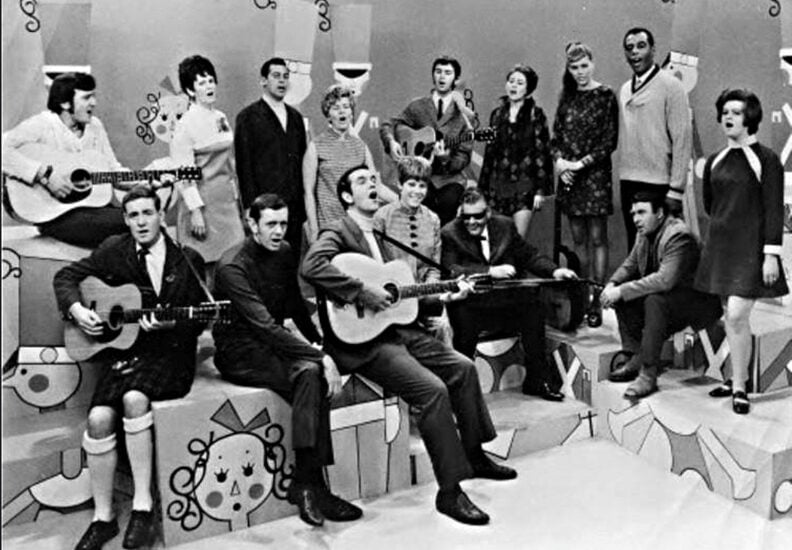
KJIPUKTUK (Halifax) – As a young child in the Bennet family, we quickly familiarized ourselves with important family rituals. We learned to walk the rocky shoreline in Glen Haven, harvest field raspberries, and to sing the various lyrics of songs written by our adored grandfather Jim Bennet.
Many of the songs we’ve now memorized go back to Jim’s time as a feature on various CBC productions, most notably as his long-time role as co-host on Singalong Jubilee.
Singalong was, without contest, a hallmark production of CBC Halifax during the sixties and early seventies. It was a popular television production that featured a large cast of singers and musicians taking turns leading each other in performances of folk songs. The show aired weekly and was renewed for almost a decade. It elevated the careers of many, including Canadian icons Anne Murray and Edith Butler, and marked the transition from black and white to full colour television in the Maritimes. you can walk into a record store in Halifax on any day and chances are good you will still find a used Singalong vinyl record for sale there.
Jim’s role on Singalong had a huge effect in shaping our family culture, and it continues to be a treat to sit with him and learn more about his time with the CBC. However, video footage of the production is almost non-existent…almost.
Prior to the pandemic, we launched a personal project: visiting the Nova Scotia Archives on a weekly basis, accessing the CBC records, and (with proper copyright permission) making our own recordings of as many of the shows as possible to share with our family. Up until then, we had only ever seen one or two minutes of the show through bootlegged versions on Youtube.
Accessing and recording the archives is a time consuming process, requiring us to watch each show in its entirety and is often hampered by tampering with old reel-to-reel machines. But the richness in these tapes has been overwhelming and we’re looking forward to getting back to this once the pandemic subsides.
Meanwhile, we’ve been reflecting on several things we’ve learned from this project, and the implication that these learnings can have on our modern day arts and culture.
First, and most simply, we learned that making music and singing are fun. It provides an escape into a joyous community of musicians united with one goal in mind: to sing, to enjoy music.
I use the term “musicians” lightly. I can hear a chorus of people (pun intended) going, “oh, but I’m not a musician! I can’t sing!” Yet, what Singalong shows us time and again is that music, and, indeed, any art form, is a wholesome and happy way of expressing communal joy.
Singalong originated in a time of optimism post-WWII in Canada, and the optimism of that show fed back into society in a cyclical way. The singers enjoyed creating music with their friends, and in turn the viewers at home were welcomed into the Singalong community with folk songs they recognized and could share with the world around them.
Art is useful for sharing our inner turmoil and concerns, for protesting against injustice and lamenting grief. But too often we forget to let it express something much needed to balance those emotions: joy. Optimism is one of the jobs of the arts, and we’ve learned that through Singalong’s weekly celebrations of the world.
In our trips to the Archives we also witnessed how Singalong fully realizes the arts’ ability to be a ritual that shows us who we are, affirms what our identity is, and how we want to be in the world. The show demonstrates that Maritime society is diverse. Folks with disabilities, people of colour, those with accents, tall folks and shorter folks are all represented.
Recognizing the standards of the time, the production was a leading example of diversified casting, and in doing this Singalong shows its audience that we are a society of many. And what about our identity? Singalong affirms for us that our identity is influenced cross-culturally by featuring songs in English, French, Swahili, and Gaelic (just to name a few), while at the same time reminding us that we are a Maritime community, set to the backdrop of a rustic wooden set adorned with nets, lobster traps, and even a canoe.
Week in and week out, Singalong also articulates how we want to be in the world, and in a deeper sense how we want to relate to one another in this diverse, multicultural community. Despite being hosted by Bill Langstroth and our grandfather Jim, the hosting duties are minimal and the performances highlight different individuals on the cast, giving them their own time for featured songs and spoken dialogue.
Moreover, the cast sits in one communal group and after each song they applaud one another for a job well done. On a weekly basis, the production showed us how to give space for one another’s voices, how to listen, celebrate one another’s achievements, support one another, and recognize that an individual’s success is what brings the group success. They laugh at mistakes (while live on air) and they poke fun at each other like a loving family.
It’s these wholesome lessons that permeate through the screen to the individuals and families singing along at home that make the show such a wonderful thing to experience. And these wholesome, underlying teachings are a fundamental piece of what made this program such a success.
Finally, Singalong has shown us how drastically the nature and goals of television (and media arts generally) have changed in the last 50 years. Gone are the days when a regular Sunday evening would consist of live folk songs on CBC.
But, there’s no reason it can’t still be this way. Singalong’s legacy shows how the arts can be wholesome, simple, instructive, and important all at once. Given the growing social disconnect in our modern lives, productions that teach these values and reflect the world that Singalong represented are needed now more than ever to forge community vision and combat isolationism.
With thanks to the staff at the Nova Scotia Archives, in particular Barry Smith for his welcome company, expertise, shared appreciation for Singalong Jubilee, and wonderful stories.
Claire and Jack Bennet are local Haligonians involved in the cultural industries. Claire is a freelance editor and writer, whose work has been published in The Coast. Jack is an arts professional, heavily involved with the Big Sing and Choirs for Change, and beginning studies at Dalhousie’s Schulich School of Law this September.
With a special thanks to our generous donors who make publication of the Nova Scotia Advocate possible.
Subscribe to the Nova Scotia Advocate weekly digest and never miss an article again. It’s free!



